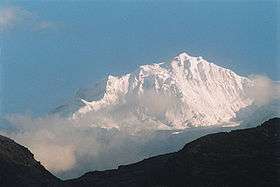Kabru
| Kabru | |
|---|---|
 Kabru South, from the south from Dzongri in Sikkim | |
| Highest point | |
| Elevation |
7,412 m (24,318 ft) Ranked 65th |
| Prominence | 780 m (2,560 ft) |
| Listing |
List of mountains in India List of mountains in Nepal |
| Coordinates | 27°38′06″N 88°07′06″E / 27.63500°N 88.11833°ECoordinates: 27°38′06″N 88°07′06″E / 27.63500°N 88.11833°E |
| Geography | |
 Kabru Location in India - Nepal border | |
| Location | India–Nepal border |
| Parent range | Himalaya |
Kabru is a mountain in the Himalayas on the border of eastern Nepal and India. It is part of a ridge that extends south from Kangchenjunga and is the southernmost 7,000 metres (23,000 ft) peak in the world.
The main features of this ridge are as follows (north to south):
- Kangchenjunga south top, 8476 m, at 27°41′30″N 88°09′15″E / 27.69167°N 88.15417°E
- A 6600–6700 m saddle, located at 27°39′51″N 88°09′39″E / 27.66417°N 88.16083°E
- A 7349 m summit, known as Talung, at 27°39′18″N 88°07′51″E / 27.65500°N 88.13083°E
- A 6983 m saddle, at 27°38′51″N 88°07′21″E / 27.64750°N 88.12250°E
- A 7412 m summit, at 27°38′06″N 88°07′06″E / 27.63500°N 88.11833°E. This point has sufficient prominence to be classified as the highest point of a separate mountain, according to the definition used in List of highest mountains. It is confusingly referred to by some authorities as "Kabru IV", but it is not clear that this is correct, or that any "Kabru" name is correctly applied to this summit.
- A substantial "field of firn" measuring about 2 km from north to south, and 1 km from east to west. This is almost entirely over 7200 m, and the watershed divide that runs through this field does not drop below this height.
- A 7338 m summit, at ca. 27°37′09″N 88°07′28″E / 27.61917°N 88.12444°E, at the eastern boundary of the field of firn. This point is known as Kabru North. Although it is lower than the 7412 m summit, it has been at times considered to be Kabru's highest point, with the higher summit considered to be an unnamed summit along the ridge to Kangchenjunga.
- An intervening c.7200 m saddle
- A 7318 m summit, at 27°36′30″N 88°06′42″E / 27.60833°N 88.11167°E, known as Kabru South is the southernmost "7000 m peak" in the world.
To the south west of Kabru south, there is a 6400 m saddle and a 6682 m summit known as Rathong. To its south east is the 6600 m Kabru Dome.
Mountaineering

The 7338 m summit of Kabru is the site of a mountaineering altitude record, either in 1883 or in 1905. The English barrister William Graham, the Swiss hotelier Emil Boss and the Swiss mountain guide Ulrich Kauffmann reported to have reached a point 30-40 feet below this summit, which Graham described as "little more than a pillar of ice", at 2pm on October 8, 1883. The ascent was questioned by powerful members of the Alpine Club and the Indian Survey Department, though not by their Himalayan climbing colleagues, and has been dismissed for most of the time since. Recent analysis suggests that the mountaineers may have been correct in their assertions after all.[1] If Graham, Boss and Kaufmann did climb to ~7325 m on Kabru it was a remarkable achievement for its time, breaking the existing altitude record by at least 360 m (assuming a pre-Columbian ascent of Aconcagua) and holding on to it for twenty-six years (when in 1909 an expedition led by Luigi Amedeo, Duke of the Abruzzi reached about 7500 m on Chogolisa).
If their account is dismissed, the same peak nevertheless became the site of an undisputed altitude record on 20 October 1907, when the Norwegians Carl W. Rubenson and Monrad Aas came within 50 m of climbing it. Notably, Rubenson and Aas believed that Kauffmann, Boss and Graham had reached the same point 34 years before.[1]
Kabru North was reached by C.R.Cooke on 18 November 1935, without oxygen. It remained the highest solo climb until 1953.
According to the 1996 version of the Himalayan Journal (pp. 29–36), members of an Indian Army expedition reached the summit of Kabru IV in May 1994. Kabru South was also climbed by an Indian party in 1994.
In 2004, a group of Serbian climbers unsuccessfully attempted the mountain. A series of avalanches forced the group to give up their goal.
The north-northwest pillar of Talung was first climbed in 2015 by two Ukrainian climbers, Mikhail Fomin and Nikita Balabanov, who won the Piolet d'Or for their climb. It was the fifth ascent of Talung.[2][3]
References
- 1 2 Willy Blaser and Glyn Hughes, Kabru 1883, a reassessment, The Alpine Journal 2009, p. 209
- ↑ Burns, Cameron M. (December 7, 2015), "Ukrainian Climbers Score Major Route on Mt. Talung", Alpinist, retrieved 2016-04-28.
- ↑ "Piolets d'Or 2016: four ascents honoured", Planet Mountain, April 7, 2016, retrieved 2016-04-28.
| Wikimedia Commons has media related to Kabru. |